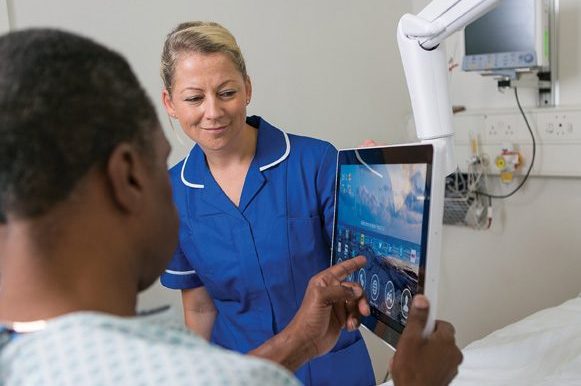Healthcare IT is taking great steps. New technologies, apps and devices pop up every day, connecting healthcare and technology. EHR systems is probably the best known example of healthcare accepting technology. But lets talk about patient entertainment systems, a lesser discussed healthcare IT area.
What about the entertainment package hospitals offer their patients? We all agree patients deserve to have a little fun why they are laid up in hospital beds. But what if patients entertainment systems did not just keep patients happy, but would actually help them get better?
This is not just wishful thinking, it is already possible.
There are several factors that help work towards a speedy recovery of the patient. Things that will speed up the process and make the whole experience less daunting. Patient entertainment systems are right in the center of encouraging better healthcare outcomes. In more than one way.
Patient Entertainment & Communication
It goes without saying that patient entertainment systems offer patients a way to relax. It is what most people consider the main functionality of these kind of systems. They offer TV channels, movies on demand, radio and lots of games to pass some time. But just entertainment is not enough.
Hospital stays can be very daunting and lonely for patients of all ages. They can make anybody feel down and that is never positive for their recovery. That is why it is so important to ensure patients feel connected to the outside world.
Friends and family are only allowed to visit them on set times during the day. Which isn’t a lot when you’re in such a vulnerable state.
Patient entertainment systems let patients stay in touch with their loved ones. They can stay up to date on the latest buzzthrough their social media accounts or use Skype to video chat. Knowing you can always contact someone if you need them, takes away some of the frustration of being confined to the hospital.
Information Access for Hospital Staff
Patient entertainment systems are mainly a source of entertainment and communication for patients. However, the systems should also be integrated in the staff’s day to day lives.
Technological advancements have now made it possible to integrate patient entertainment systems into the patient stay from beginning to end.
Doctors and nurses can use them to pull up x-rays and show them to the patient right at their bedside. Or show them any other information from their EHR.
Focus on information access through patient entertainment systems is a positive development for patient care. It means not only a way for patients to access entertainment but also for doctors to access clinical information. It may even mean access to clinical information by patients too.
Patient entertainment systems can also become hubs by connecting them to the hospital’s information system (HIS). Connecting them to the HIS system will help hospital staff identify which patient is in what bed.
Even further so, having all the patient’s information on the patient entertainment system will mean this information can be used to better serve the patient. For example, meal ordering through the patient entertainment system can now be done based on dietary restrictions.
Patient Engagement through Interactive Patient Care
Many patients have said they were on the outside looking in on their own care experience. The doctor-patient relationship used to be a one way interaction for a long time. But technology has now made it a two way street.
Many companies have developed devices and software that solely focus on centralizing and activating the patient. The patient was always the central point of the care plan, but they were static elements.
Patient entertainment systems and other healthcare technology solutions have activated the patient into being involved and having a say in their care experience.
Hospitals have seen the positive effects of engaging patients in their care process. And while healthcare technology is still very clinician based, the focus point is shifting to the patient. Many hospitals aim at providing entertainment while also proactively engaging patients and their families. Leveraging the clinicians workflows.
The point of this is taking advantage of the entertainment part of patient entertainment systems to get people involved. It’s not about patients actively using the entertainment system to find cool movies to watch to keep themselves busy.
It’s about fully understanding the systems. And how they integrate in their care process. Deeply involving patients that way.









